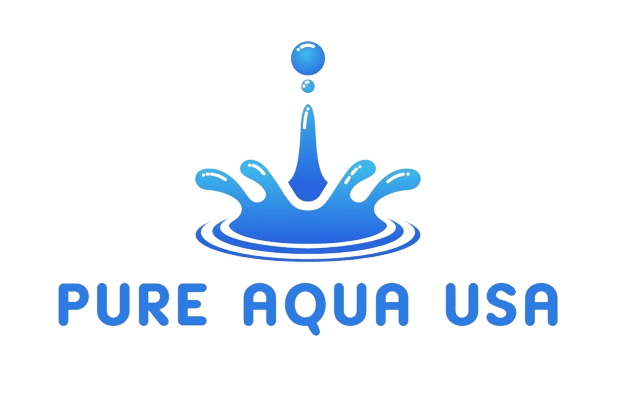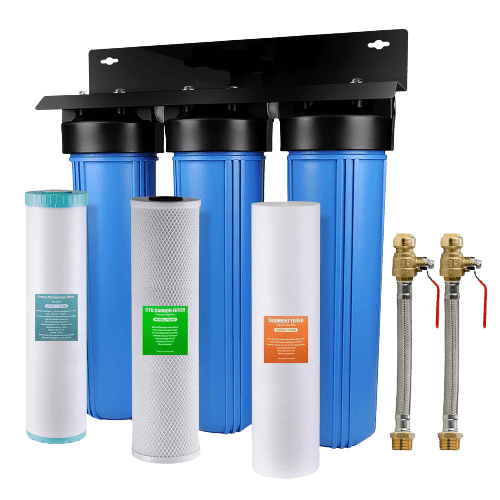Your cart is currently empty!
Filter Housings
Big Blue filter housings are heavy-duty, large-sized filtration containers designed to accommodate oversized filter cartridges. They are well-suited for residential, commercial, and industrial water filtration applications, offering high capacity, high-flow capabilities, and compatibility with various filter media. The clear sump design provides visibility into the filtration process, while the robust construction and user-friendly features make maintenance and filter replacement straightforward.
- Description
- Additional information
- Specifications
- Installation Instructions
- Maintenance
- Replacement Parts
- Q&A
- Advantages and Disadvantages
- Downloads
- Drawings
- Reviews (0)
Description
Big Blue filter housings are large-sized, heavy-duty filtration containers commonly used in water treatment and filtration systems. These housings are designed to accommodate oversized filter cartridges, providing ample surface area for effective filtration and ensuring a high flow rate suitable for various residential, commercial, and industrial applications.
The term “Big Blue” typically refers to a specific type of filter housing that is known for its wide diameter, usually ranging from 4.5 to 10 inches, allowing for greater dirt-holding capacity and extended cartridge life. These housings come in different materials, such as durable polypropylene or reinforced plastics, ensuring resilience and longevity in diverse operating conditions.
Big Blue filter housings are often utilized in whole-house water filtration systems, commercial water treatment setups, and industrial process water filtration. Their robust construction and large-capacity design make them suitable for addressing high flow rates and handling substantial water volumes while effectively removing sediment, chlorine, and other contaminants from the water supply.
These filter housings typically feature a pressure release button for safe and easy cartridge replacement, as well as a built-in pressure relief valve to prevent unwarranted pressure build-up during filter changes. Additionally, they may include a mounting bracket for secure installation and are compatible with a wide range of filter cartridges, providing flexibility and customization based on specific water treatment needs.
Overall, Big Blue filter housings are recognized for their robustness, versatility, and efficiency in addressing the diverse filtration requirements of residential, commercial, and industrial water systems. Their large capacity, high-flow capabilities, and compatibility with various filter media make them a practical choice for achieving clean, high-quality water across different applications.
Big Blue filters often feature a one-inch inlet and outlet port, allowing for smooth water flow while minimizing pressure drop. This design not only supports efficient water filtration but also ensures that the system can handle high flow rates without compromising performance.
In addition to their large capacity and high flow capabilities, Big Blue filter housings are often designed with a clear sump, or housing body, which provides visibility into the filtration process. This transparency allows users to monitor the condition of the filter cartridge, making it easier to determine when a replacement is necessary.
The versatility of Big Blue filters extends to their compatibility with various filter media, including sediment, carbon, and specialty cartridges designed to address specific water quality concerns. This adaptability enables users to customize their filtration systems based on the unique contaminants present in their water supply.
For maintenance and filter replacement, Big Blue filter housings typically feature a robust and user-friendly design. The filter wrench, specifically tailored for Big Blue housings, facilitates easy opening and closing during cartridge changes, ensuring a secure seal and optimal filtration performance.
Overall, the combination of robust construction, high-flow capabilities, visibility into the filtration process, and compatibility with different filter media makes Big Blue filter housings a reliable and versatile choice for achieving effective water filtration in residential, commercial, and industrial settings.
Additional information
| Size | 2-1/2" x 10", 2-1/2" x 20", 4-1/2" x 10", 4-1/2" x 20" |
|---|---|
| Body Color | CL-Clear, BL-Blue, BK-Black, SS-Stainless Steel |
| Inlet / Outlet | 1/4", 1/2", 3/4", 1" |
| System Size | Single Filter, Dual Filter, Tri filter, Quad Filter |
| Pressure Relief | No, Yes |
| Gauges | 1, 2, 3 |
Specifications
Installation Instructions
Here are some general installation instructions for water treatment filter housings:
- Select a Location: Choose a suitable location for installing the water treatment filter housing. Consider proximity to the water source, available space for maintenance access, and ensuring proper support for the housing.
- Shut Off Water Supply: Before beginning installation, shut off the water supply to the area where the filter housing will be installed. This may involve closing a main water valve or isolating the specific water line.
- Prepare the Mounting Surface: If the housing will be wall-mounted, use a level to ensure the mounting surface is flat and mark the positions for attaching the mounting bracket securely.
- Install Mounting Bracket: Attach the mounting bracket to the chosen location using appropriate fasteners, ensuring it is securely fixed to support the weight of the filter housing when filled with water.
- Connect Inlet and Outlet: Attach the appropriate plumbing fittings to the inlet and outlet ports of the filter housing, adhering to the manufacturer’s recommendations for proper sizing and sealing.
- Install Filter Cartridge: Insert the filter cartridge into the housing, following the provided instructions to ensure proper alignment and sealing. Some cartridges may require pre-soaking or flushing before installation.
- Secure Housing: Mount the filter housing onto the previously installed bracket, ensuring a tight seal around the cartridge and proper alignment of the inlet and outlet connections.
- Turn On the Water Supply: Once the housing is securely installed, turn on the water supply and check for any leaks or unusual noises. Monitor the system for a few minutes to ensure proper water flow through the filter housing.
- Perform Initial Flush: Before use, perform an initial flush of the system to purge any air and activate the filter cartridge. Follow the manufacturer’s recommendations for flushing procedures.
- Check for Leaks: After installation and flushing, carefully inspect all connections and the housing for any signs of leaks. Address any issues promptly to prevent water damage.
These general instructions can help guide the installation of water treatment filter housings. Remember to always consult the specific installation manual provided by the manufacturer for detailed guidance tailored to the particular model of filter housing being installed.
Maintenance
Replacement Parts
Q&A
Q: What is a water treatment filter housing?
A: A water treatment filter housing is a container that holds a water filter cartridge in place and directs the flow of water through the cartridge to remove impurities.
Q: What types of impurities can water treatment filter housings remove?
A: Water treatment filter housings can remove various impurities such as sediment, chlorine, bacteria, and other contaminants, depending on the type of filter cartridge used.
Q: What sizes and materials are water treatment filter housings available in?
A: Water treatment filter housings come in a variety of sizes to accommodate different filter cartridges and flow rates. They are typically made of materials such as polypropylene, stainless steel, and fiberglass-reinforced plastic.
Q: How do I select the right water treatment filter housing for my application?
A: When selecting a water treatment filter housing, consider factors such as the flow rate of water, the type and size of contaminants to be removed, and the compatibility of the housing with the filter cartridge.
Q: What maintenance is required for water treatment filter housings?
A: Routine maintenance for water treatment filter housings may include replacing filter cartridges, inspecting for leaks or cracks, and cleaning the housing to prevent the buildup of sediment and contaminants.
Q: Can water treatment filter housings be used for residential applications?
A: Yes, water treatment filter housings are commonly used in residential applications to improve the quality and taste of drinking water. They can be installed at point-of-use or point-of-entry for whole-house water filtration.
Q: Are there specific installation requirements for water treatment filter housings?
A: Water treatment filter housings should be installed by the manufacturer’s guidelines, ensuring proper positioning, secure connections, and adequate support to handle the flow and pressure of water.
Q: Can water treatment filter housings be used in conjunction with other water treatment systems?
A: Yes, water treatment filter housings are often used alongside other water treatment systems such as water softeners, reverse osmosis systems, and UV sterilization units to provide comprehensive water purification.
Q: How long do water treatment filter housings typically last?
A: The lifespan of water treatment filter housings can vary depending on factors such as water quality, usage, and maintenance. Regular inspection and replacement of filter cartridges can help prolong the life of the housing.
Q: Are there any environmental considerations related to water treatment filter housings?
A: Proper disposal of used filter cartridges and adherence to local regulations for handling and disposing of contaminants removed from water are important environmental considerations when using water treatment filter housings.
Advantages and Disadvantages
Here are some advantages and disadvantages of water treatment filter housings:
Advantages:
- Improved Water Quality: Water treatment filter housings effectively remove sediment, chlorine, contaminants, and other impurities, resulting in cleaner and better-tasting water.
- Versatility: These housings can accommodate a variety of filter cartridges, allowing for customized filtration based on specific water quality concerns.
- Cost-Effective: Using water treatment filter housings can reduce the frequency of filter changes and maintenance, potentially saving costs over time.
- Easy Maintenance: Routine maintenance, such as replacing filter cartridges and cleaning the housing, is generally straightforward and can be done without specialized tools.
- Compatibility: Water treatment filter housings can be used in conjunction with other water treatment systems, such as reverse osmosis units or UV sterilizers, for comprehensive water purification.
Disadvantages:
- Initial Cost: The upfront cost of purchasing and installing water treatment filter housings may be a consideration, particularly for larger or more advanced systems.
- Space Requirements: Depending on the size and capacity of the housing, adequate space for installation and maintenance needs to be considered.
- Flow Rate Limitations: Some filter cartridges and housings may have limitations on flow rates, requiring careful selection to ensure sufficient water pressure and flow for the intended application.
- Regular Maintenance: While maintenance is generally straightforward, it is important to adhere to a regular maintenance schedule to ensure optimal performance and prevent issues such as clogging or leaks.
- Environmental Impact: Disposal of used filter cartridges and management of contaminants removed from water are important considerations for minimizing environmental impact.
Overall, water treatment filter housings offer effective water filtration and customization options, but it’s essential to consider factors such as upfront costs, maintenance requirements, and space limitations when selecting and using these systems.
Downloads
Drawings
Only logged in customers who have purchased this product may leave a review.










Reviews
There are no reviews yet.